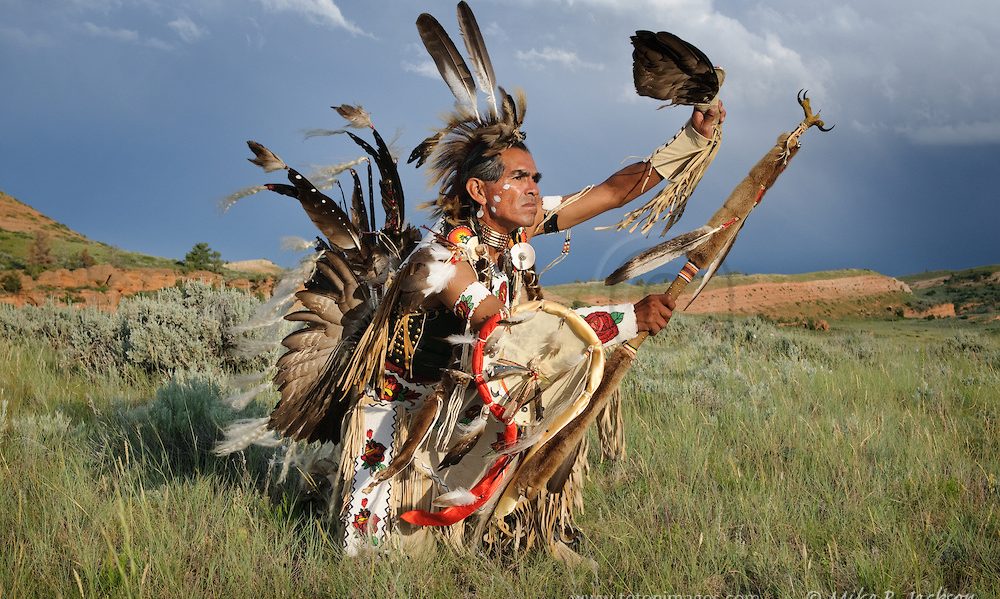The Shoshone tribes believed in supernatural powers that took the shape of animals and other creatures. Some were different from tribe to tribe, the most popular was the Coyote, their mischievous and trickster father of the people; Wolf, Coyote’s brother and wise and revered hero, the creator of the earth; and a people called Nimerigar (Nim-air-ee-gar), a magical race of violent little people that the Shoshone would battled in their myths. Other figures that usually took the shape of animals, these are the deities that the Shoshone people believed in and it shaped their culture very much.
Shoshones based their religion off of visions and dreams that were received from the spirit world. Some of these dreams were sought after as quests where a specific animal spirit would give powers to the individual, usually young males, and they would receive guidance. They would go to great lengths to receive these visions, going so far as to fast for multiple days and nights without food, water, or fire, and sometimes cutting off parts of their bodies as sacrifice or creating puncture wounds in their chests to drag buffalo heads on a hook, which would often rip out and tear the wounds open further.
The Shoshone tribes toady are split between many different religions, but these practices are still carried out in various reservations and celebrations. Other religious practices of the Shoshone include the Native American Church, adopted from the Plains Indians, as well as over half the tribe populations belonging to Baptist, Roman Catholic, Latter Day Saint, and Episcopal religions.
They are connected so much with the earth and life around them that much of their sense of self is derived from this connection. They connect humans, animals and plants, the physical with the spiritual, and the living with the non-living to create a holistic sense of self. This purpose became difficult for the Shoshone tribes as American settlers moving westward pushed them from their land. Physical separation from their land causes the Shoshone Indians to be disoriented and have a decreased sense of purpose. As they lost their land, they lost their connection to the land in addition to much of their sense of self and purpose. Without land of their own, maintaining their sense of self became very difficult for the Shoshone Indians.
Treaty in 1868 “From this day forward peace between the parties to this treaty shall forever continue. The Government of the United States desires peace, and its honor is hereby pledged to keep it. The Indians desire peace and they hereby pledge their honor to maintain it. If bad men among the whites, or among other people subject to the authority of the United States, shall commit any wrong upon the person or property of the Indians, the United States will, upon proof made to the agent and forwarded to the Commissioner of Indian Affairs, at Washington City, proceed at once to cause the offender to be arrested and punished according to the laws of the United States”. This treaty was breached and the Shoshone were forcibly moved to Fort Hall, in 1888 they had no choice but to sale 420,000 acres of their land and these lands became part of the “day of the run” land rush.
The Shoshone’s children like all other Tribes were forced to attend boarding school one of these schools was the Stewart Indian School, it was open from 1890-1980 with a federal mandate to educate American Indian children, initially from the Great Basin Tribes (Washoe, Northern and Southern Paiute, and Western Shoshone). The intent of the Indian boarding school was not to prepare the American Indian children for higher education, but to educate them enough so they could work in the dominant society, “away from their culture and traditions”. Stewart alumni Indian School took in young native children that were forcibly removed from their homes to live on the Stewart Indian School campus, these resulted in a traumatic time for both the children and their parents.
The Tribes today have a new Language and Culture Department that oversees the protection of cultural heritage sites on the reservation. They also host language-oriented programs and cultural events throughout the year, on and off the reservation. The Tribes conduct the Shoshone-Bannock Festival annually in August in Fort Hall and participate in a reunion of all Shoshonean/Numic speaking tribes each year at various locations throughout the west.
http://www.shoshonebannocktribes.com/treaty.html
http://www.shoshonebannocktribes.com/shoshone-bannock-history.html


Thank you for giving so much detail on the Sho Shone’s traditional religion, it is interesting to be able to see what they came from not just how the conversion went. I’m kind of astonished that the United States even bothered making treaties with Native American tribes, considering they broke every one I’ve ever heard of. I’ve never heard the excuse for the school being so the children could fit into the dominate work force. Considering the First Amendment of the U.S. they should be allowed to work no matter what their culture or religion.
LikeLike
Your descriptions of the Shoshone Indians religions were really great. It was very organized and the amount of research you did showed in your blog. I thought it was really interesting that they would go without food, water, and fire to receive powers from animal spirits. And even the extreme of cutting off body parts…it seems so farfetched, but it was their culture and religion and should have been respected by the European settlers. Thank you so much for sharing what you found.
LikeLike
Thank you for the great detail of the Shoshone life. It was very interesting and informational.
LikeLike
Tracy,
I really appreciated all of the detail you added in your post to really help your readers understand the full aspect of the story and history of the Shoshone religion and the traditions they practiced. This was a very well written and interesting blog post. Thank you so much for sharing!
Kylie
LikeLike